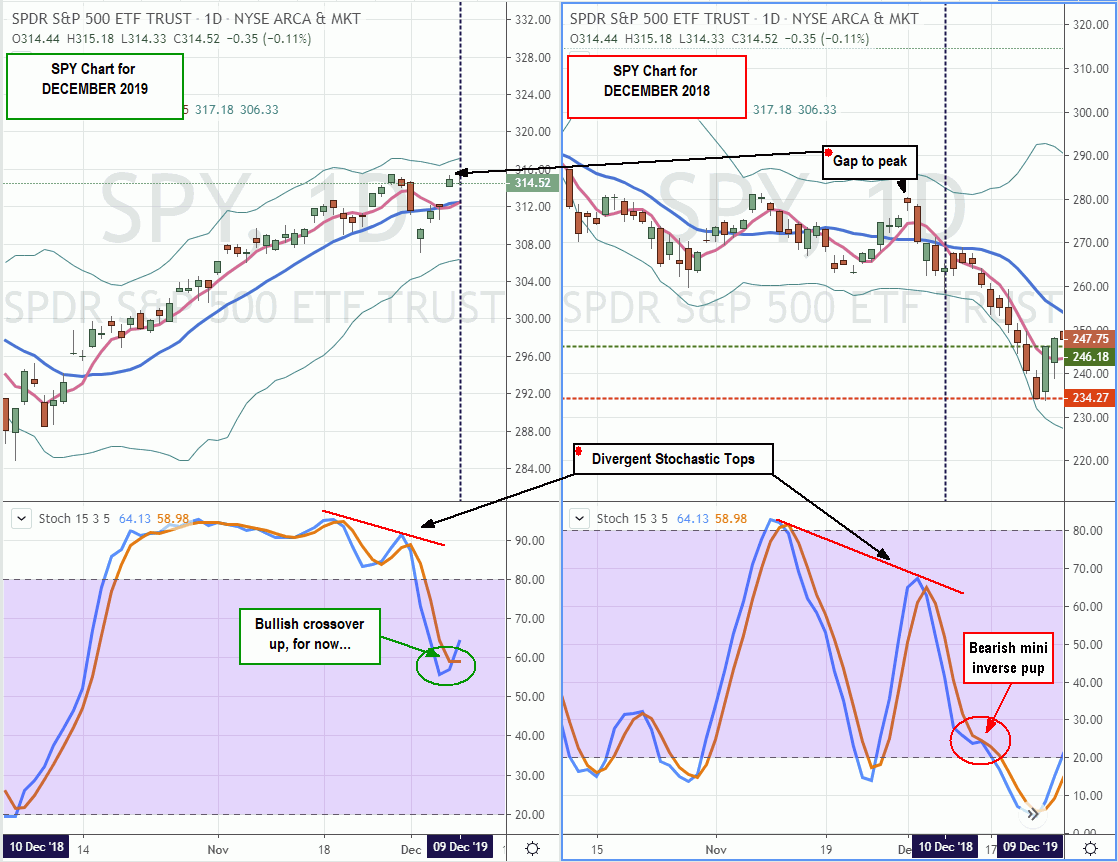As we head into the final weeks of December 2019, traders and investors alike can’t help but wonder if December concludes with the traditional holiday melt-up rally or repeat a brutal melt-down like December 2018. There are many similarities with last year but also stark differences. We will look at the catalysts to compare both potential scenarios as markets get ready to close out the year.

December Trading Activity
The month of December is notorious for having very thin liquidity as funds close out their books as managers take holiday vacations. This thin liquidity usually results in stabilized and rising markets as sentiment is lifted and positive with no surprises. However, the thin liquidity can be a double-edged sword when panic ensues from unexpected catalysts. December 2018 was a perfect storm of unexpected catalysts lead by Federal Reserve chairman Jerome Powell when he inadvertently expressed a hawkish stance referring to the interest policy and the scheduled balance sheet reductions during their final FOMC rate decision session. Thin liquidity results in algorithms running wild leapfrogging each other to take whatever liquidity remains. This can create extensive and extreme movements in either direction. In December, light volume tends to favor rising (floating) markets, but heavy volume tends to occur in falling markets. The combination of China tariff uncertainties with a hawkish Fed created a perfect storm of market pressure causing the S&P 500 ETF (NYSEARCA: SPY) to collapse from a peak of $280.40 to a low of $234.27 in 15-trading sessions only saved by the Dec. 24th fund rebalancing buy programs that triggered a reversal bounce.
The Un-Expected Catalyst
While Chinese trade talks were a hot and volatile catalyst last year heading into a January 2019 tariff deadline, the markets were braced for a reaction. This holds true for the upcoming December 15, 2019 tariff deadline, which is an expected catalyst. Last year’s hawkish comments from Fed Chairman Powell were unexpected and took the market by surprise. One could argue that if the same comments were made just a month earlier, the market sell-off wouldn’t have been so dramatic just because there would have been more liquidity to absorb the reaction. For the most part, markets have shrugged off China trade tariff reactions as they ground to all-time highs in December 2019.
If the markets sell-off, it’s very likely not as a result of the China tariffs. It needs to be an unexpected catalyst such as a drastic degradation of trade talks, physical incapacitation of the U.S. President, major bank failure, sovereign default, surprise interest rate hike or an act of war. Sound extreme? It needs to be.
Rifle Chart Comparisons of the SPY
Comparing the SPY daily rifle charts for both Decembers indicates some similarities but more contrasts. In December 2018, the stochastic on the daily SPY chart formed a diverging top by making two consecutive lower peaks on the downside crossovers at the 80-band and 70-band, respectively. When they attempted the crossover up at the 25-band, it got flushed with a mini inverse pup pattern triggering a trap-door sell-off collapsing the SPY from 260s to 234s by Dec. 23.
Similarly, December 2019’s stochastic also produced a divergent daily stochastic top but at higher levels, the 95-band and 90-band, respectively. The daily stochastic did manage to crossover back up by recovering from 307s on four successive price gaps triggering short-squeezes on melt-up fashion. It is important to note that gaps ultimately need to be filled, however, that can happen in January. The bulls are taking full advantage of the thinner liquidity to keep the market floating.
Potential SPY Chart Outcomes
With four consecutive price gaps, the SPY can form a nominal reversion to re-test the five-period simple moving average (SMA) at 312.50 before resuming the uptrend towards the 315.75-to-318.85 range. If the bears manage to break the 307.50 support coupled with a stochastic crossover down, then it could start to mirror the December 2018 pattern of a bearish mini inverse pup. The nominal downside is the lower Bollinger Bands which would place downside towards the 305.60-to-304.20 levels. In other words, nothing as drastic as December 2018 is in the cards even if the China tariffs kick in on the 15th. It’s almost important to note that many fund managers are severely underperforming the averages this year and pressured to put money to work even at extreme prices. Barring any severely unexpected events, markets are likely not going to repeat 2018’s December sell-off.
Before you make your next trade, you'll want to hear this.
MarketBeat keeps track of Wall Street's top-rated and best performing research analysts and the stocks they recommend to their clients on a daily basis.
Our team has identified the five stocks that top analysts are quietly whispering to their clients to buy now before the broader market catches on... and none of the big name stocks were on the list.
They believe these five stocks are the five best companies for investors to buy now...
See The Five Stocks Here
Just getting into the stock market? These 10 simple stocks can help beginning investors build long-term wealth without knowing options, technicals, or other advanced strategies.
Get This Free Report
Like this article? Share it with a colleague.
Link copied to clipboard.